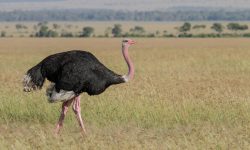The majestic Golden Eagle and the iconic Bald Eagle are two of North America’s most powerful raptors. Often mistaken for one another due to their size and strength, these eagles have distinct traits that set them apart. Whether you’re a birdwatcher, photographer, or simply fascinated by wildlife, understanding their differences helps you appreciate their unique beauty.
This comprehensive guide explores 10 key differences between Golden Eagles and Bald Eagles, including their appearance, habitat, behavior, diet, and more.
Overview of the Two Eagles

Before diving into the differences, let’s get a quick overview of each species.
Feature |
Golden Eagle (Aquila chrysaetos) |
Bald Eagle (Haliaeetus leucocephalus) |
|---|---|---|
Wingspan |
6 to 7.5 feet |
6 to 7.5 feet |
Body Length |
27–33 inches |
28–40 inches |
Weight |
7–14 pounds |
6.5–14 pounds |
Coloration |
Dark brown with golden nape |
White head and tail, dark brown body |
Habitat |
Mountains, cliffs, and open terrain |
Lakes, rivers, and coastal areas |
Diet |
Small mammals and birds |
Fish and carrion |
Range |
Northern Hemisphere (North America, Europe, Asia) |
North America (U.S., Canada, Alaska) |
1. Appearance and Coloration
Golden Eagle
The Golden Eagle gets its name from the beautiful golden feathers on the back of its head and neck. Its body is mostly dark brown, with lighter golden tones that shimmer under sunlight. The legs of the Golden Eagle are feathered all the way to the talons, which gives it a regal and powerful look.
Bald Eagle
In contrast, the Bald Eagle is unmistakable with its pure white head and tail feathers that stand out against its dark brown body. Despite the name, it’s not actually bald — the term comes from the Old English word “balde,” meaning white. Juvenile Bald Eagles lack the white head and tail, making them harder to distinguish from Golden Eagles until they mature at around five years old.
2. Habitat and Range
Golden Eagle
Golden Eagles prefer vast open areas, including mountains, cliffs, and deserts. They are commonly found in western North America, but also inhabit Europe and Asia. These raptors build their nests, called eyries, on cliffs or high trees, giving them an excellent vantage point to spot prey.
Bald Eagle
Bald Eagles are closely tied to water sources. They thrive near lakes, rivers, and coastal regions where fish are abundant. Their nests are usually found in tall trees close to water, particularly in Alaska, Canada, and the northern United States. In recent decades, conservation efforts have helped their populations rebound across the U.S.
3. Diet and Hunting Behavior
Golden Eagle
Golden Eagles are fierce predators, relying mainly on their hunting skills. They target rabbits, squirrels, prairie dogs, and even foxes or small deer. With remarkable speed and precision, they dive at up to 150 miles per hour to capture their prey with razor-sharp talons.
Bald Eagle
Bald Eagles are primarily fish eaters, often seen swooping down to snatch fish from the water’s surface. However, they are also opportunistic feeders and won’t hesitate to scavenge carrion or steal food from other birds, including Ospreys. Their powerful beaks allow them to tear flesh efficiently, making them both hunters and scavengers.
4. Flight Style and Speed
Golden Eagle
Golden Eagles are agile and fast flyers. Their flight is characterized by powerful wingbeats followed by long glides. They can reach incredible diving speeds of up to 150–200 miles per hour, rivaling even the Peregrine Falcon in bursts of speed.
Bald Eagle
Bald Eagles, while also strong fliers, are less agile than Golden Eagles. They soar gracefully at high altitudes, often circling over lakes or rivers. Their top flight speed averages around 75–100 miles per hour when diving.
5. Behavior and Temperament
Golden Eagle
Golden Eagles are known for their solitary and territorial nature. They defend large hunting territories and are rarely seen in groups outside the breeding season. Their behavior reflects a more aggressive and predatory temperament.
Bald Eagle
Bald Eagles are more social, especially during the winter months when they congregate around large bodies of water to feed. They are often seen in pairs or family groups, and sometimes even tolerate other eagles nearby.
6. Nesting and Breeding Habits
Golden Eagle
Golden Eagles build massive nests made of sticks and lined with soft materials like grass and fur. These nests are typically found on cliffs or tall trees and can be reused and expanded year after year, sometimes reaching up to 10 feet in diameter. They lay one to three eggs per season, with both parents sharing incubation duties.
Bald Eagle
Bald Eagles are also famous for their enormous nests — the largest of any bird in North America. Built in tall trees near water, their nests can weigh over a ton. They generally lay two eggs, and both parents take turns incubating and feeding the chicks.
7. Size and Physical Strength
Golden Eagle
Golden Eagles have a slightly more robust body structure relative to their wingspan. Their talons exert immense pressure, making them capable of capturing and lifting prey heavier than themselves.
Bald Eagle
While Bald Eagles appear larger due to their broader wings, they are generally lighter-bodied than Golden Eagles. Their strength lies in their grip and beak, which is designed for tearing flesh rather than killing prey outright.
8. Voice and Calls
Golden Eagle
Golden Eagles are relatively quiet compared to Bald Eagles. Their calls are high-pitched and weak, often described as whistles or chirps. They vocalize mostly during courtship or territorial disputes.
Bald Eagle
Bald Eagles, on the other hand, have a distinctive series of high-pitched whistles or chirping sounds that are easily recognizable. Their vocalizations play a vital role in communication between mates and young.
9. Lifespan and Survival
Golden Eagle
Golden Eagles live an average of 25–30 years in the wild. Their longevity depends on territory stability and prey availability. They face threats from habitat loss, illegal shooting, and collisions with power lines.
Bald Eagle
Bald Eagles can live up to 30 years in the wild and even longer in captivity. Conservation laws and habitat protection have allowed their numbers to recover dramatically since the 1970s when they were near extinction due to pesticide use (DDT).
10. Symbolism and Cultural Importance
Golden Eagle
The Golden Eagle is revered across many cultures as a symbol of strength, courage, and freedom. It holds significance in Native American traditions and is the national bird of several countries, including Mexico and Kazakhstan.
Bald Eagle
The Bald Eagle holds a unique place in American culture as the national bird and emblem of the United States. It symbolizes freedom, power, and independence, appearing on government seals, currency, and official emblems since 1782.
Comparison Summary: Golden Eagle vs Bald Eagle
Category |
Golden Eagle |
Bald Eagle |
|---|---|---|
Scientific Name |
Aquila chrysaetos |
Haliaeetus leucocephalus |
Plumage |
Dark brown with golden neck feathers |
White head and tail, brown body |
Habitat Preference |
Mountains and open terrain |
Near lakes, rivers, and coasts |
Diet |
Mammals and birds |
Mainly fish and carrion |
Flight Speed |
Up to 200 mph (dive) |
Up to 100 mph (dive) |
Behavior |
Solitary and territorial |
More social, especially near food sources |
Nesting Site |
Cliffs and tall trees |
Tall trees near water |
Call Type |
High-pitched whistles |
Chirps and squeals |
Cultural Symbol |
Strength and courage (worldwide) |
Freedom and independence (U.S.) |
How to Identify Them in the Wild
If you encounter a large raptor soaring above, there are a few easy ways to tell whether it’s a Bald Eagle or a Golden Eagle.
-
Head and Tail Color: Adult Bald Eagles have white heads and tails, while Golden Eagles do not.
-
Feathered Legs: Golden Eagles have fully feathered legs; Bald Eagles’ legs are bare yellow.
-
Habitat Clue: Spot one near a lake or river? It’s likely a Bald Eagle. High in the mountains? Probably a Golden Eagle.
-
Behavior: Golden Eagles are more likely to be seen hunting actively; Bald Eagles often scavenge or steal from other birds.
Observing these differences can help even novice birdwatchers make accurate identifications.
Conservation Status
Both eagles have faced population challenges in the past. The Golden Eagle remains stable globally but vulnerable in some regions due to habitat destruction and human interference. The Bald Eagle, once endangered, has made a remarkable comeback after being removed from the U.S. Endangered Species List in 2007. Ongoing conservation programs continue to monitor both species to ensure their protection.
Which One Is More Powerful?
When it comes to strength and hunting prowess, the Golden Eagle often takes the lead due to its agility and predatory instincts. However, the Bald Eagle’s size and dominance around water give it an edge in its own environment. Each species reigns supreme in its respective habitat — the Golden Eagle over mountains and the Bald Eagle over waterways.
Final Thoughts
Both the Golden Eagle and the Bald Eagle are extraordinary raptors, representing power, majesty, and freedom. While the Bald Eagle may hold more fame as the U.S. national symbol, the Golden Eagle’s unmatched hunting skills and grace in flight make it equally fascinating.
Understanding their differences helps deepen our appreciation for these birds and the ecosystems they dominate. Whether you see a Bald Eagle perched by a river or a Golden Eagle soaring above the mountains, you’re witnessing two of nature’s most awe-inspiring creatures in their element.






